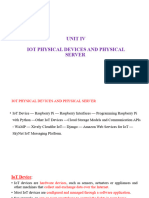0% found this document useful (0 votes)
98 views14 pagesIoT Devices & Raspberry Pi Basics
The document discusses the basic building blocks of IoT devices. It describes how IoT devices can consist of modules for sensing, actuation, and communication. Sensors can collect information like temperature and humidity, actuators can control devices, and communication modules can send and receive data from other devices and cloud servers. It then focuses on single-board computers like Raspberry Pi, pcDuino, BeagleBone Black, and Cubieboard as examples of IoT devices. Raspberry Pi runs various Linux flavors and supports sensors and actuators through GPIO pins. It has interfaces like HDMI, Ethernet, USB and status LEDs. Linux commands are used frequently with Raspberry Pi.
Uploaded by
R RCopyright
© © All Rights Reserved
We take content rights seriously. If you suspect this is your content, claim it here.
Available Formats
Download as PDF, TXT or read online on Scribd
0% found this document useful (0 votes)
98 views14 pagesIoT Devices & Raspberry Pi Basics
The document discusses the basic building blocks of IoT devices. It describes how IoT devices can consist of modules for sensing, actuation, and communication. Sensors can collect information like temperature and humidity, actuators can control devices, and communication modules can send and receive data from other devices and cloud servers. It then focuses on single-board computers like Raspberry Pi, pcDuino, BeagleBone Black, and Cubieboard as examples of IoT devices. Raspberry Pi runs various Linux flavors and supports sensors and actuators through GPIO pins. It has interfaces like HDMI, Ethernet, USB and status LEDs. Linux commands are used frequently with Raspberry Pi.
Uploaded by
R RCopyright
© © All Rights Reserved
We take content rights seriously. If you suspect this is your content, claim it here.
Available Formats
Download as PDF, TXT or read online on Scribd
/ 14
































































